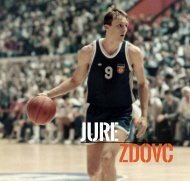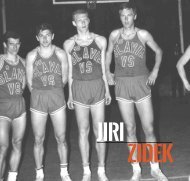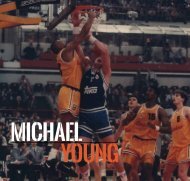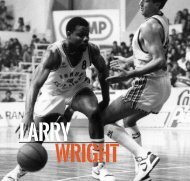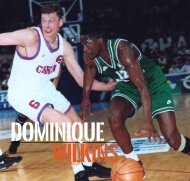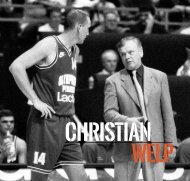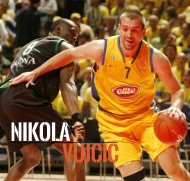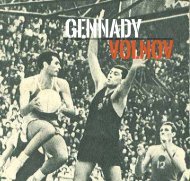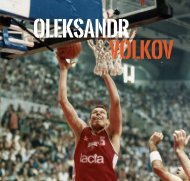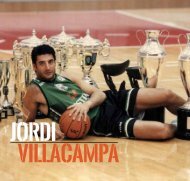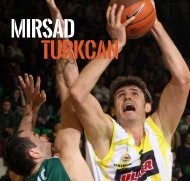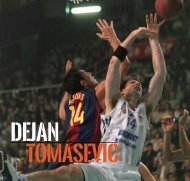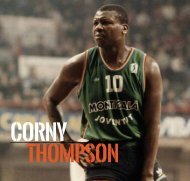101 Greats of European Basketball
Create successful ePaper yourself
Turn your PDF publications into a flip-book with our unique Google optimized e-Paper software.
The legend <strong>of</strong> Split<br />
In the world <strong>of</strong> basketball there are many players<br />
who share the name, but among the greats – if I am<br />
not mistaken – there are just two who are called<br />
Dino. One is Meneghin, the other, Radja. Both are,<br />
oddly enough, centers. When Dino Radja came into<br />
the world in Split, Croatia on April 24, 1967, Meneghin<br />
was already a pro player, a major prospect for<br />
Ignis Varese and Italian basketball. Because Meneghin<br />
had such a long career, the Dinos had time to face<br />
each other in club domestic, EuroLeague and national<br />
team competitions, in part due to Radja spending<br />
three seasons in the Italian League before leaving for<br />
the NBA to play with the Boston Celtics.<br />
From the beginning <strong>of</strong> the 1960s until the mid-1990s,<br />
Split was a great basketball center. The yellow jersey <strong>of</strong><br />
Jugoplastika has been worn by many greats over several<br />
generations. The first great team there, coached by<br />
Branko Radovic – who is considered the father <strong>of</strong> basketball<br />
in Split – was formed by Petar Skansi, the three Tvrdic<br />
brothers – Rato, Lovre and Drazen – Damir Solman,<br />
Zdenko Prug and Mihajlo Manovic. After that, they had<br />
Zeljko Jerkov, Duje Krstulovic, Ivica Dukan and Goran<br />
Sobin. They led up to the generation <strong>of</strong> the likes <strong>of</strong> Radja,<br />
Toni Kukoc, Zan Tabak, Velimir Perasovic and the others<br />
who won three EuroLeague crowns in a row from 1989<br />
to 1991, the first two <strong>of</strong> which came under the orders <strong>of</strong><br />
Boza Maljkovic, the creator <strong>of</strong> that great team.<br />
When talking about the great Jugoplastika, the<br />
names <strong>of</strong> Kukoc and Radja were almost always pronounced<br />
together as the two main pillars on which the<br />
success <strong>of</strong> that team was based. Radja is one year older<br />
than Kukoc. He started playing at the humble KK Dalvin<br />
club in Split, but as a junior he already made the jump to<br />
Jugoplastika. By the 1983-84 season, he had played his<br />
first minutes on the first team for Kreso Cosic, a great<br />
former player and a not-so-great coach, but one who<br />
had the courage and the eye to promote young talent<br />
into the sport. Radja scored his first basket on December<br />
15, 1984, in Belgrade against Partizan. After Cosic,<br />
the Jugoplastika bench saw other names like Slavko<br />
Trninic and Pino Grdovic (together) and later Zoran<br />
Slavnic, who, true to his style, said: “Dino Radja will be a<br />
miracle player.” Slavnic had said something similar, and<br />
he had been absolutely right, a few years earlier about<br />
a certain Drazen Petrovic, whom he trained in Sibenik.<br />
Slavnic was right again.<br />
The young center Radja progressed with giant steps.<br />
His talent opened the doors <strong>of</strong> the national team, even<br />
though he didn’t make the cut to be at the 1985 <strong>European</strong><br />
Championship for Cadets in Ruse, Bulgaria. There,<br />
Vlade Divac, Kukoc, Nebojsa Ilic, Slavisa Koprivica and<br />
Radenko Dobras started a path that would culminate<br />
two years later at the 1987 U19 <strong>Basketball</strong> World Cup in<br />
Bormio, Italy. Before that, however, for the 1986 <strong>European</strong><br />
Championship for Junior Men tourney in Gmunden,<br />
Austria, Radja formed a duo with Divac as a key piece<br />
<strong>of</strong> the team coached by Svetislav Pesic. Yugoslavia was<br />
an even stronger team then – with new faces like Radja,<br />
Aleksandar Djordjevic, Luka Pavicevic and Teoman<br />
Alibegovic – and won another title. For the 1987 Euro-<br />
Basket in Athens, Cosic called the four great prospects:<br />
Kukoc, Divac, Djordjevic and Radja. They came back<br />
home with the bronze medal and then, in August, went<br />
back to their junior team for the U19 World Cup in Bormio.<br />
There, they won the gold medal by twice beating<br />
a great USA Team, coached by Larry Brown, with Kevin<br />
<strong>101</strong> greats <strong>of</strong> european basketball<br />
Dino Radja<br />
R



